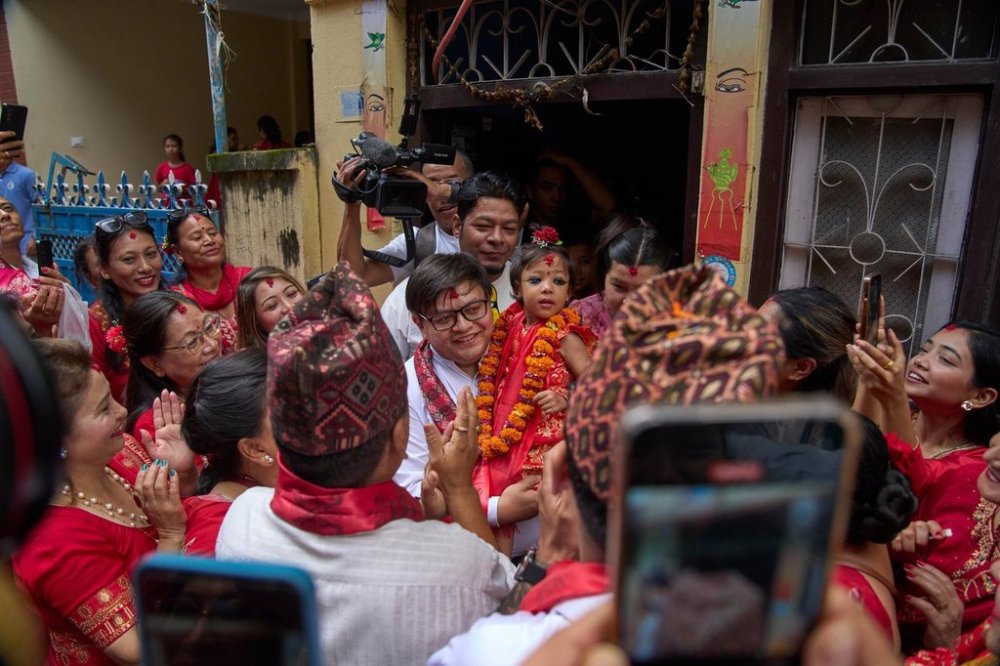Nepal chooses a 2-year-old girl as new living goddess worshipped by both Hindus and Buddhists
Advertisement
Read this article for free:
or
Already have an account? Log in here »
To continue reading, please subscribe:
Monthly Digital Subscription
$1 per week for 24 weeks*
- Enjoy unlimited reading on winnipegfreepress.com
- Read the E-Edition, our digital replica newspaper
- Access News Break, our award-winning app
- Play interactive puzzles
*Billed as $4.00 plus GST every four weeks. After 24 weeks, price increases to the regular rate of $19.00 plus GST every four weeks. Offer available to new and qualified returning subscribers only. Cancel any time.
Monthly Digital Subscription
$4.75/week*
- Enjoy unlimited reading on winnipegfreepress.com
- Read the E-Edition, our digital replica newspaper
- Access News Break, our award-winning app
- Play interactive puzzles
*Billed as $19 plus GST every four weeks. Cancel any time.
To continue reading, please subscribe:
Add Winnipeg Free Press access to your Brandon Sun subscription for only
$1 for the first 4 weeks*
*$1 will be added to your next bill. After your 4 weeks access is complete your rate will increase by $0.00 a X percent off the regular rate.
Read unlimited articles for free today:
or
Already have an account? Log in here »
KATHMANDU, Nepal (AP) — A 2-year-old girl chosen as Nepal’s new living goddess was carried by family members from their home in a Kathmandu alley to a temple palace Tuesday during the country’s longest and most significant Hindu festival.
Aryatara Shakya, at 2 years and 8 months, was chosen as the new Kumari, or “virgin goddess,” replacing the incumbent, who is considered by tradition to become a mere mortal upon reaching puberty.
Kumaris are chosen from the Shakya clans of the Newar community, indigenous to the Kathmandu valley, and revered by both Hindus and Buddhists in the predominantly Hindu nation.

The girls are selected between the ages of 2 and 4 and are required to have unblemished skin, hair, eyes and teeth. They should not be afraid of the dark.
During the Indra Jatra festival earlier this month, the former Kumari was wheeled around on a chariot pulled by devotees. The Kumari always wears red, pins up her hair in topknots and has a “third eye” painted on their forehead.
The weeklong Indra Jatra festival was the first of a series of celebrations in October including Dashain, the main festival, and Tihar or Diwali, the festival of lights.
Tuesday marked the eighth day of Dashain, a 15-day celebration of the victory of good over evil. Offices and schools were closed as people celebrated with their families.
Family, friends and devotees paraded the new Kumari through the streets of Kathmandu before entering the temple palace, which will be her home for several years.
Devotees lined up to touch the girls’ feet with their foreheads, the highest sign of respect among Hindus in the Himalayan nation, and offered her flowers and money. The new Kumari will bless devotees including the president Thursday.
“She was just my daughter yesterday, but today she is a goddess,” her father Ananta Shakya said, adding that there were already signs she would be the goddess before her birth. “My wife during pregnancy dreamed that she was a goddess and we knew she was going to be someone very special.”
The former Kumari Trishna Shakya, now aged 11 years old, left from a rear entrance on a palanquin carried by her family and supporters. She became the living goddess in 2017.
Families of the Shakya clan who qualify for the prestigious seat compete to have their daughters selected. The family of the Kumari gains an elevated position in society and within their own clan.
But Kumaris live a sequestered life. They have few selected playmates and are allowed outside only a few times a year for festivals.
Former Kumaris face difficulties adjusting to normal life, learning to do chores and attending regular schools. Nepalese folklore says men who marry a former Kumari will die young, which has resulted in many of the girls remaining unmarried.
Over the past few years, there have been many changes in tradition and the Kumari is now allowed to receive an education from private tutors inside the temple palace and even have a television set.
The government also offers retired Kumaris a small monthly pension of about $110, which is slightly above the minimum wage fixed by the government.
The Free Press acknowledges the financial support it receives from members of the city’s faith community, which makes our coverage of religion possible.


